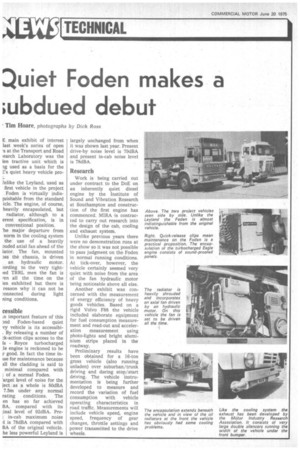Quiet Foden makes a ;ubdued debut
Page 48

If you've noticed an error in this article please click here to report it so we can fix it.
Tim Hoare, photographs by Dick Ross E main exhibit of interest last week's series of open 's at the Transport and Road :earch Laboratory was the len tractive unit which is ag used as a basis for the -1's quiet heavy vehicle pro:.
Inlike the 'Leyland, used as first vehicle in the project Foden is virtually indisNishable from the standard ice. The engine, of course, heavily encapsulated, but radiator, although to a erent specification, is in conventional position.
'he major departure from norm in the cooling system the use of a heavily 3uded axial fan ahead of the iator. The fan, mounted ass the chassis, is driven an hydraulic motor. :ording to the very tight ed men the fan is ten all the time on the Len exhibited but there is reason why it can not be ;onnected during light fling conditions.
cessible
,n important feature of this and Foden-based quiet vy vehicle is its accessibi. By releasing a number of .7.k-action clips access to the Is Royce turbocharged :le engine is reckoned to be 9 good. In fact the time inIse for maintenance because all the cladding is said to minimal compared with of a normal Foden.
'arget level of noise for the ject as a whole is 80dBA 7.5m under any, normal rating conditions. The en has so far achieved BA, compared with its ;inal level of 92dBA. Pre: in-cab maximum noise is 78dBA compared with BA of the original vehicle. he less powerful Leyland is largely unchanged from when it was shown last year. Present drive-by noise level is 79dBA and present in-cab noise level is 78dBA.
Research
Work is being carried out under contract to the DoE on an inherently quiet diesel engine by the Institute of Sound and Vibration Research at Southampton and construction of the first engine has commenced. MIRA -is contracted to carry out research into the design of the cab, cooling and exhaust system.
Unlike previous years there were no demonstration runs at the show so it was not possible to pass judgment on the Foden in normal running conditions. At tick-over, however, the vehicle certainly seemed very quiet with noise from the area of the fan hydraulic motor being noticeable above all else.
Another exhibit was concerned with the measurement of energy efficiency of heavy goods vehicles. Based on a rigid Volvo F88 the vehicle included elaborate equipment for fuel consumption measurement and read-out and acceleration measurement using photo-lights and bright aluminium strips placed in the roadway.
Preliminary results have been obtained for a 16-ton gross vehicle (also running unladen) over suburban/trunk driving and during stop/start driving. The vehicle instrumentation is being further developed to measure and record the variation of fuel consumption with vehicle operating characteristics in road traffic. Measurements will include vehicle speed, engine speed, frequency of gear changes, throttle settings and power transmitted to the drive wheels.




























































































































































